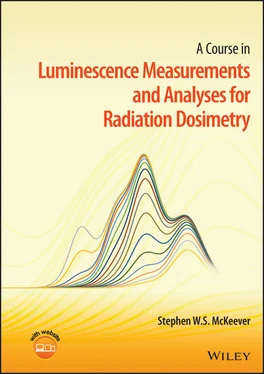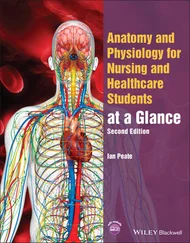5 Chapter 5Figure 5.1 (a) First-order TL peaks, calculated using the Randall...Figure 5.2 (a) The principle of step annealing and the definition of...Figure 5.3 (a) “Saw-tooth” heating profile for the method of...Figure 5.4 Results of the IRM using the Gobrecht-Hofmann...Figure 5.5 Schematic illustration of the method of the Van...Figure 5.6 Concept for the...Figure 5.7 A schematic representation of the...Figure 5.8 (a) By choosing a particular temperature T in...Figure 5.9 (a) TL glow curve consisting of three first-order peaks...Figure 5.10 The same analysis as...Figure 5.11 Definitions of the temperatures...Figure 5.12 Variation of the shape...Figure 5.13 (a) First-order TL...Figure 5.14 (a) Schematic of the...Figure 5.15 (a) Glow curves made...Figure 5.16 An example fit (red...Figure 5.17 Parameters...Figure 5.18 Two TL peaks for...Figure 5.19 Fitting of “pseudo...Figure 5.20 (a) A simulated distribution...Figure 5.21 (a) Top view of...Figure 5.22 Calculated TL glow curve...Figure 5.23 Calculated data for a...Figure 5.24 Simulated temperature dependence of...Figure 5.25 Illustration of the change...Figure 5.26 (a) Variation in the...Figure 5.27 (a) Variation in the...Figure 5.28 Variation in...Figure 5.29 (a) CW-OSL and...Figure 5.30 Top row: fits to...Figure 5.31 A “pseudo-LM...Figure 5.32 Variation in the LM...Figure 5.33 CW-OSL curves (top...Figure 5.34 In the lower right...Figure 5.35 (a) Assumed Gaussian distribution...
6 Chapter 6Figure 6.1 (a) The OTOR model...Figure 6.2 Schematic examples of dose...Figure 6.3 Linear-supralinear-saturating dose...Figure 6.4 Same plot as Figure...Figure 6.5 A supralinear then linear...Figure 6.6 A 2T1R interactive model...Figure 6.7 Numerical solutions to Equations...Figure 6.8 Supralinear dose-response relationship...Figure 6.9 A 1T2R interactive model...Figure 6.10 Example results for the...Figure 6.11 Schematic notion of an...Figure 6.12 Schematic model of a...Figure 6.13 (a) A 2T2R competition...Figure 6.14 Changes in TL glow...Figure 6.15 Changes in CW-OSL...Figure 6.16 Schematic visualization of (a...Figure 6.17 Track structure for three...Figure 6.18 (a) Schematic radial dose...Figure 6.19 The concept of track...Figure 6.20 (a) First-nearest-neighbor...Figure 6.21 Schematic representation of the...Figure 6.22 (a) A simulated RPL...
7 Chapter 7Figure 7.1 (a) Normalized glow curve...Figure 7.2 (a) Normalized TSDC intensity...Figure 7.3 Typical optical absorption spectrum...Figure 7.4 Thermal stability of the...Figure 7.5 (a) Isometric plot of...Figure 7.6 Glow curves from TLD...Figure 7.7 Conceptual notion of trap...Figure 7.8 (a) Fit to the...Figure 7.9 T ...Figure 7.10 Changes in various optical...Figure 7.11 TL response of TL...Figure 7.12 TL as a function...Figure 7.13 Plots of...Figure 7.14 (a) TL glow curves...Figure 7.15 An XRD spectrum for...Figure 7.16 TL glow curves for...Figure 7.17 Optical absorption for LiF...Figure 7.18 An isometric plot of...Figure 7.19 Example TL emission spectrum...Figure 7.20 Changes to the glow...Figure 7.21 Changes to the TL...Figure 7.22 A semi-transparent overlay...Figure 7.23 The dose-response characteristics...Figure 7.24 TL Efficiency...Figure 7.25 (a) Supralinearity index (dose...
8 Chapter 8Figure 8.1 Crystal lattice (HCP) for...Figure 8.2 (a) Optical absorption spectrum...Figure 8.3 (a) CW-OSL, (b...Figure 8.4 (a) OSL simulation and...Figure 8.5 Flat band diagram indicating...Figure 8.6 Top: Variation of the...Figure 8.7 POSL emission spectrum from...Figure 8.8 LM-OSL curves for...Figure 8.9 (a) A VE-OSL...Figure 8.10 Experimental TA-OSL (TA...Figure 8.11 CW-OSL curves from...Figure 8.12 Dose-response function for...Figure 8.13 (a) Example CW-OSL...Figure 8.14 Supralinearity index...Figure 8.15 Ratio of the...Figure 8.16 Different methodologies for using...Figure 8.17 Results using the methods...Figure 8.18 CW-OSL relative efficiency...Figure 8.19 (a) Fluence-response characteristics for high-energy...Figure 8.20 Comparison of the dependence on pre-heat temperature...
9 Chapter 7Figure 9.1 AlNa 3...Figure 9.2 EPR spectrum at room...Figure 9.3 Optical absorption spectrum for...Figure 9.4 (a) The model of...Figure 9.5 (a) Emission and (b...Figure 9.6 Emission spectrum (325 nm...Figure 9.7 A normalized RPL decay...Figure 9.8 (a) Changes to optical...Figure 9.9 (a) Buildup of RPL...Figure 9.10 RPL buildup curves for...Figure 9.11 Dependence of the buildup...Figure 9.12 (a) UV reversal of...Figure 9.13 Dose-response functions at...Figure 9.14 Changes to the orange...Figure 9.15 Optical absorption from Ag...Figure 9.16 Estimated penetration of stimulation...Figure 9.17 Dose-response functions at...Figure 9.18 Changes to the emission...Figure 9.19 RPL emission spectra from...Figure 9.20 (a) Orange RPL dose...Figure 9.21 Relative RPL efficiency of...Figure 9.22 Optical absorption spectra of...Figure 9.23 Structure of the...Figure 9.24 Excitation-emission spectra for...Figure 9.25 An FNTD image of...Figure 9.26 “3-D”...Figure 9.27 Mean track amplitude histograms...Figure 9.28 Luminescence amplitude for track images...Figure 9.29 Al 2...Figure 9.30 Track density versus neutron dose for...Figure 9.31 Optical absorption in beta-irradiated, pure...Figure 9.32 F- and F 2-centers in LiF.Figure 9.33 Excitation and emission spectra...Figure 9.34 FNTD images of 56Fe...Figure 9.35 Three-dimensional FNTD images...Figure 9.36 Luminescence intensity distributions in...Figure 9.37 Track luminescence intensity versus LET...
10 Chapter 10Figure 10.1 Compositional phase diagram for feldspar.Figure 10.2 Structure of feldspar based on...Figure 10.3 Conceptual representation of random potential...Figure 10.4 Translation of Figure 10.3 into a...Figure 10.5 Stimulation (excitation) spectra for IRSL...Figure 10.6 Temperature dependence of the IRSL...Figure 10.7 (a) IRSL decay curves at 10 K and 300 K,...Figure 10.8 Stimulation (excitation) spectra for OSL...Figure 10.9 CW-OSL decay curve at room temperature...Figure 10.10 Changes in the TL glow curves from microcline...Figure 10.11 TL from an andesine sample irradiated at room...Figure 10.12 Variation of...Figure 10.13 Excitation and emission spectra for RPL...Figure 10.14 Decay of the RPL signal from K-feldspar...Figure 10.15 Example composition distribution for...Figure 10.16 Example possible aluminosilicate glass...Figure 10.17 A collection of OSL decay curves from...Figure 10.18 (a) Normalized BLSL and GLSL CW-OSL curves...Figure 10.19 Excitation spectra for aluminosilicate glass from...Figure 10.20 A comparison of two BLSL curves from...Figure 10.21 (a) BLSL fading curves for a variety of GG...Figure 10.22 Dose-response functions for aluminosilicate...Figure 10.23 (a) Typical TL glow curve from an aluminosilicate...Figure 10.24 TL emission spectrum from an aluminosilicate...Figure 10.25 T m- T ...Figure 10.26 (a) A “pseudo” TL glow curve...Figure 10.27 (a) Fading of the TL from the 470 K to 513 K...
1 Chapter 3Table 3.1 Example expressions for...
2 Chapter 5Table 5.1 Values for constant...Table 5.2 Values of resolution...Table 5.3 Values for...
3 Chapter 10Table 10.1 Fitted...
1 Cover
2 Title page
3 Copyright
4 Dedication
5 Table of Contents
6 Preface
7 Acknowledgments
8 Disclaimer
9 About the Companion Website
10 Begin Reading
11 References
12 Index
13 End User License Agreement
1 i
2 ii
3 iii
4 iv
5 v
6 vi
7 vii
8 viii
9 ix
10 x
11 xi
12 xii
13 xiii
14 xiv
15 xv
16 xvi
17 xvii
18 xviii
19 xix
20 xx
21 1
22 2
23 3
24 4
25 5
26 6
27 7
28 8
29 9
30 10
31 11
Читать дальше












